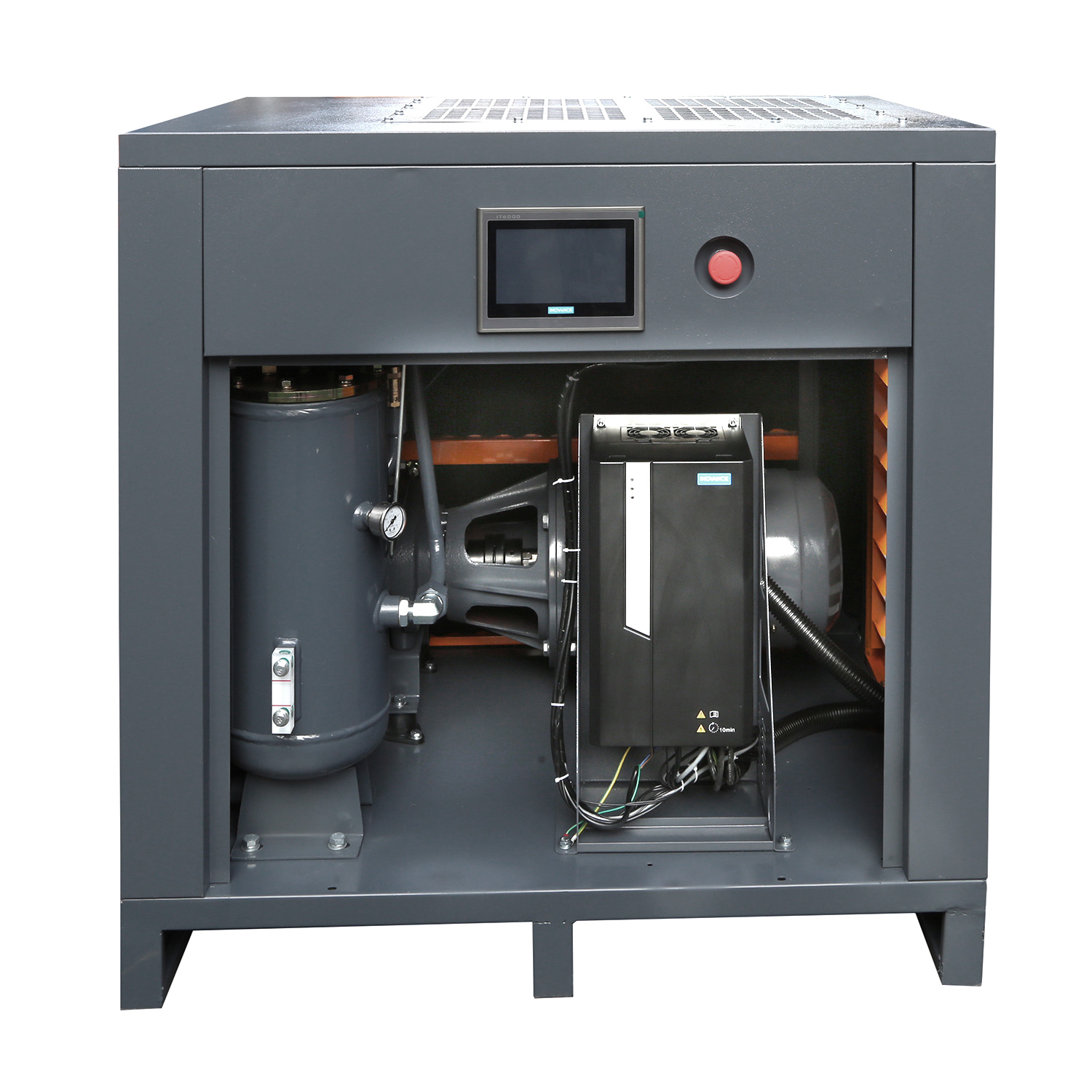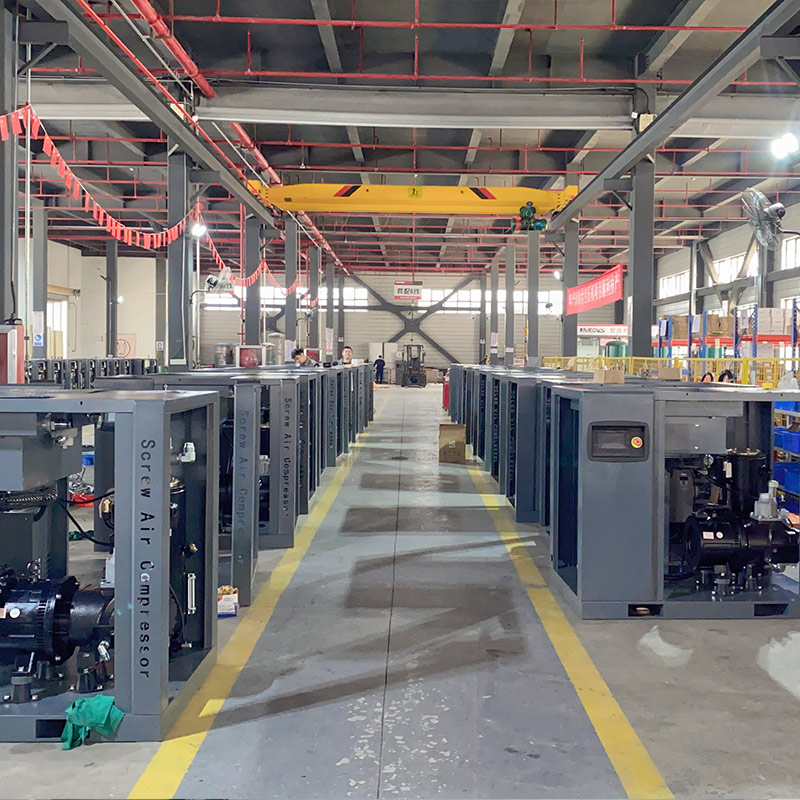Examination and Treatment of Compressor System Leakage
As a relatively complex mechanical system equipment, the compressor has various failures, and “running, leaking, leaking” is one of the most common and common failures. Compressor leakage is actually a common glitch, but it occurs frequently and there are many types. When we inspected and overhauled leaking faults, we counted about 20 to 30 types. These are some of the frequent faults, and there are also some small leaks that may have occurred once in many years.
Seemingly small problems can lead to very serious consequences. Taking compressed air as an example, even a leak point as small as 0.8 mm can leak up to 20,000 cubic meters of compressed air every year, causing an additional loss of about 2,000 yuan. In addition, leakage will not only directly waste expensive electric energy and cause a burden on electricity bills, but also may cause excessive pressure drop in the system, reduce the functional efficiency of pneumatic equipment, and shorten the life of the equipment. At the same time, “false demand” due to air leaks can lead to more frequent loading and unloading cycles, increasing the running time of the air compressor, which can lead to additional maintenance requirements and possible increased unplanned downtime. Simply put, compressed air leaks increase unnecessary compressor operation. These multiple blows have prompted us to pay attention to leaks. Therefore, no matter what kind of leakage failure is encountered, it should be dealt with in time after discovery.
For various leakage phenomena encountered in general air compressor stations, we conduct statistics and analysis one by one.
1. Valve leakage
There are many valves on the air pressure system, there are various water valves, air valves and oil valves, so the probability of valve leakage is very high. Once a leak occurs, the small one can be replaced, and the large one needs to be overhauled.
1. Leakage occurs when the closure part falls off
(1) Do not use too much force to close the valve, and do not exceed the upper dead point when opening the valve. After the valve is fully opened, the handwheel should be reversed a little;
(2) The connection between the closing part and the valve stem should be firm, and there should be stoppers at the threaded connection;
(3) The fasteners used to connect the closing member and the valve stem should withstand conventional acid and alkali corrosion, and have certain mechanical strength and wear resistance.
2. Leakage of the sealing surface
(1) Correctly select the material and type of the gasket according to the working conditions;
(2) The bolts should be tightened evenly and symmetrically. If necessary, a torque wrench should be used. The pre-tightening force should meet the requirements and should not be too large or small. There should be a certain pre-tightening gap between the flange and the threaded connection;
(3) The assembly of gaskets should be aligned in the middle, and the force should be uniform. The gaskets are not allowed to overlap and use double gaskets;
(4) The static sealing surface is corroded, damaged, and the processing quality is not high. Repair, grinding and coloring inspection should be carried out to make the static sealing surface meet the relevant requirements;
(5) When installing the gasket, pay attention to cleanliness. The sealing surface should be cleaned with kerosene, and the gasket should not fall to the ground.
3. Leakage at the joint of the sealing ring
(1) Adhesive should be injected to seal the leak at the rolling place and then rolled and fixed;
(2) Remove the screws and the pressure ring to clean, replace the damaged parts, grind the sealing surface and the connection seat, and reassemble. For parts with large corrosion damage, it can be repaired by welding, bonding and other methods;
(3) The connecting surface of the sealing ring is corroded, which can be repaired by grinding, bonding, etc. If it cannot be repaired, replace the sealing ring.
4. Valve body and bonnet leakage
(1) The strength test shall be carried out in strict accordance with the regulations before installation;
(2) For valves with temperature between 0° and below 0°, heat preservation or heat tracing should be carried out, and stagnant water should be removed for valves that are out of service;
(3) The welding seam of the valve body and bonnet composed of welding shall be carried out in accordance with the relevant welding operation procedures, and flaw detection and strength tests shall be carried out after welding.
Second, the failure of the pipe thread
During our work, we have found that the pipe thread has cracks many times, resulting in leakage. Most of the processing methods are to weld the pipe thread buckle.
There are generally two methods for pipe thread welding, which are divided into internal welding and external welding. The advantage of external welding is convenience, but in that case, cracks will remain in the threaded fastener, leaving hidden dangers for future leakage and cracking. From the point of view of use, it is recommended to solve this problem from the root. Use a straight grinder to groove the cracked part, weld and fill the crack, and then re-make the welded part into a threaded button. In order to increase strength and prevent leakage, it can be welded on the outside. It should be noted that when welding with a welding machine, the correct welding wire should be selected to prevent the parts from being burned out. Make a good thread, and check that there is no problem with the plug.
3. Air bag elbow failure
The elbow part of the pipeline is most severely scoured by the flow of compressed air (the local resistance is relatively large), so it is prone to loose connections and leakage. The way we deal with it is to tighten the hoop with a pipe hoop to prevent it from leaking again.
In fact, stainless steel pipes commonly used in the industry have several connection methods such as welding, thread, and compression; aluminum alloy pipes are new material pipes that have appeared in the past ten years, and have the advantages of light weight, fast flow rate, and easy installation. Special quick connector connection, more convenient.
4. Leakage of oil and water pipes
Leakage of oil and water pipes often occurs at the joints, but sometimes leakage occurs at some elbows due to corrosion of the pipe wall, thin pipe wall, or high impact force. If a leak is found in the oil and water pipe, the machine must be shut down to find the leak, and the leak should be repaired by electric welding or fire welding. Since this kind of leakage is often caused by corrosion and wear and thinning, it is not possible to directly weld the leakage at this time, otherwise it is easy to cause more welding and larger holes. Therefore, spot welding should be done at appropriate positions next to the leak. If there is no leak in these places, a molten pool should be established first, and then, like a swallow holding mud and building a nest, it should be welded to the leak bit by bit, gradually reducing the area of the leak. , and finally seal the leak with a small-diameter welding rod.
5. Oil leakage
1. Replace the sealing ring: If the inspection finds that the sealing ring of the oil-gas separator is aging or damaged, the sealing ring needs to be replaced in time; 2. Check the accessories: sometimes the reason for the oil leakage of the oil-gas separator is that the installation is not in place or the original parts are damaged, and inspection is required And replace accessories; 3. Check the air compressor: If there is a problem with the air compressor itself, such as gas backflow or excessive pressure, etc., it will cause pressure burst in the oil-gas separator, and the air compressor fault needs to be repaired in time; 4. Check the pipeline connection : Whether the pipeline connection of the oil-gas separator is tight will also affect the oil leakage, and it needs to be checked and tightened; 5. Replace the oil-gas separator: If the above methods cannot solve the oil leakage problem, you need to replace the new oil.
6. Air leakage from the minimum pressure valve
The main reasons for the lax closure, damage and failure of the minimum pressure valve are: 1. Poor air quality or foreign impurities enter the unit, and the high-pressure airflow drives the impurity particles to impact the minimum pressure valve, resulting in damage to the valve components, or failure due to inclusion of dirt; 2. .The air compressor is filled with too much oil, too much lubricating oil, and the oil viscosity increases, causing the valve plate to close or open late; 3. The minimum pressure valve is set according to the specific working conditions. If the working conditions fluctuate too much, the minimum pressure valve will quickly Failure; 4. When the air compressor is shut down for a long time and then restarted, the moisture contained in the lubricating oil and the air will enter the interior of the equipment to accumulate and corrode various parts of the minimum pressure valve, resulting in the valve not closing tightly and leaking air.
7. Leakage caused by other pipelines
1. The sewage pipe is faulty. Corrosion of the screw thread cannot guarantee the tightness, the treatment method: welding, plugging the leak point;
2. The sewage pipe of the trench is faulty. Pipeline corrosion, trachoma, resulting in oil dripping, treatment method: welding + pipe collar, sealing treatment;
3. The fire water pipe line is faulty. After a long time of use, the iron pipe corrodes, the pipe wall becomes thinner, and leakage occurs under the action of pressure. Because the water pipe is long, it cannot be replaced as a whole. Treatment method: pipe hoop + paint, use pipe hoop to block the leak, and paint with epoxy resin to prevent oxidation and corrosion of the pipe.
4. Assembly pipe leakage failure. Leakage caused by corrosion, treatment method: clamp the pipe.
In general, all kinds of pipelines and pipeline connectors leak, and those that can be replaced should be replaced, and those that cannot be replaced should be patched, combining emergency treatment with thorough cure.
8. Other valve failures
1. The drain valve is faulty. It is generally a short wire fault, the short wire is damaged, and corrosion occurs at the elbow. Treatment method: Replace damaged short wire valves and elbows.
2. The water door is frozen and cracked, and the treatment method is to replace it.



